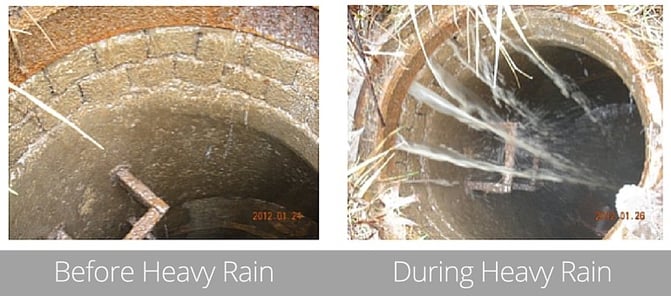Often times, I’m asked “When is it important to complete manhole inspections?” Manhole inspections should be performed during wet weather, or when the groundwater level is at its peak. Ideally, November to May is the best time to perform manhole inspections to detect inflow & infiltration (I/I). With the snow/ice melt in February and March compounded with heavy rains, Cities and Towns will notice flows spike at lift stations and wastewater treatment facilities. The five (5) most important items to take note of during manhole inspections that will help reduce (I/I) and eliminate potential backups are:
1. The Manhole Chimney During Heavy Rain
One of the most important manhole components to observe during a manhole inspection is the manhole chimney. As you can see below, this manhole was constructed of precast concrete, with the exception of the manhole chimney which was constructed of brick. During dry weather the chimney may appear to be in good shape; but when the groundwater rises or heavy rains occur, you may see a different story entirely. It is often hard to believe you are looking at the same manhole, under slightly different conditions. For reference, the inflow that was observed to the right was entering at a rate of approximately seven gallons per minute.
2. Struck During Final Grading
It is always a good idea to have a construction inspector on site during sanitary manhole installation. Additionally, a trained Construction Inspector should complete a final inspection and sign off prior to the Muncipality or Utility taking over responsibility of the sewer system. After construction, there is typically a three-year maintanace bond and inspection that should take place, but this is often times forgotton. I have frequently seen frame and covers offset due to being struck during final grading, or as a result of not being properly marked in fields that are worked by farm machinery. If these manholes are located in low-lying areas, the amount of inflow could be catastropic to your sewer system. Below are three photos of manholes that were struck during the final grading and never corrected by the utility.

3. Properly Stacked Out
Far too often, I come across sanitary sewer manholes that were not properly stacked out during construction. Most utilities and municipalities have a set of plans, specifications, and details that contractors are to follow during construction. Contractors are to supply the muncipality shop drawings to indicate what product they are installing. In many cases, for whatever reason the details and/or specifications are not adhered to, which will result in a poor final product, resulting in I/I entering the system.The photo to the left is an example of the use of brick, stone, etc. for grade adjustment, in lieu of the proper concrete adjusting ring.The photo in the center is of an O-Ring gasket that was not secure during manhole installation. The O-Ring is designed to help maintain a water tight seal at the joint. The photo to the right is an active joint leak due to an inadequate amount of Kent Seal and/or failure to apply the proper amount of butyl rubber/plastic wrap on the exterior joint. All of these deficiencies can result in infiltration entering the sanitary system.

4. Rubber Boot
One of the most common observations is a leaking pipe penetration. When a new manhole is constructed, a rubber boot should be installed on the precast manhole to facilitate installation of the sewer pipe. This boot is tightened with stainless steel bands to maintain a water tight seal. Many times, concrete is placed around the pipe in lieu of the rubber boot and the result is active infiltration at the pipe penetration as shown in the photo to the left and right. The photo in the center shows a rubber boot installed, but not tightened adequately, causing continuous active infiltration at the pipe penetration.

5. Surcharging Left an Obstruction
Last, but not least, it is a good idea to inspect the sanitary sewer system after a heavy rain to see if surcharging has occurred which can result in an obstruction in the sewer. Below are before/after cleaning photos of a manhole that had been surcharged; it is hard to believe this is the same manhole only minutes after the obstruction was removed. On a related note, it is good practice to connect sanitary sewer laterals directly to the main and not to a manhole. Below, it appears a high spot exists in the center of the channel, potentially causing backups to three property owners. Unfortunately, this will be a continued maintenance issue for the utility and property owners.

The unfortunate part about these common defects is that municipalities must dedicate funds toward sanitary sewer rehabilitation to correct items such as those above.
Have questions or want to get started? Contact Wessler with questions on how to address sources of I/I or to schedule your next round of detailed manhole inspections.
Tags


